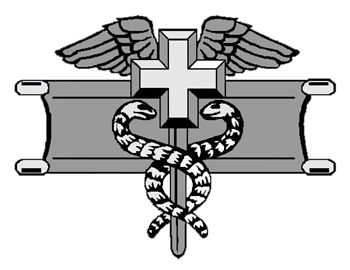 Prior to the establishment of the Expert Field Medical Badge, some AMEDD units of V Corps in Europe developed and conducted tests to ensure their soldiers were trained to the highest level of proficiency required of their wartime mission. These tests lasted for 2 1/2 days and consisted of written and practical exercises (identification of types of wounds, bandaging, application of splints, treatment of war casualties, removal of injured personnel from tanks, loading and unloading of patients from helicopters, map reading, aerial photo reading and maintenance of equipment). If they passed the test, they were issued a "Expert Medical Soldier Certificate". These tests were apparently the forerunner of the EFMB test.
Prior to the establishment of the Expert Field Medical Badge, some AMEDD units of V Corps in Europe developed and conducted tests to ensure their soldiers were trained to the highest level of proficiency required of their wartime mission. These tests lasted for 2 1/2 days and consisted of written and practical exercises (identification of types of wounds, bandaging, application of splints, treatment of war casualties, removal of injured personnel from tanks, loading and unloading of patients from helicopters, map reading, aerial photo reading and maintenance of equipment). If they passed the test, they were issued a "Expert Medical Soldier Certificate". These tests were apparently the forerunner of the EFMB test.
Establishment of an Expert Field Medical Badge as a Department of the Army special skill award for recognition of exceptional competence and outstanding performance by field medical personnel was recommended in a letter, dated 20 January 1964, from MG Duncan, Chief of Staff, US Continental Army Command to Deputy Chief of Staff for Personnel, (DCSPER), in accordance with correspondence between General Waters and General Heaton, The Surgeon General. (An earlier request, in 1963 for the same badge, was not favorably considered by DCSPER with the Army Chief of Staff for Force Development (ACSFOR) concurring with that decision.) On 14 May 1964, tentative approval of the recommendation was received from the DCSPER subject to submission of criteria to be developed by Headquarters US Continental Army Command and Assistant Chief of Staff for Force Development, DA. Design of the badge, with criteria for the award, was forwarded by Summary Sheet to DCSPER, 2 February 1965. The Summary Sheet was returned without action on 27 February 1965, having been deferred pending further study of questions posed by the Vice Chief of Staff, US Army. By Disposition Form (DF) dated 6 July 1965 from DCSPER to Commander, The Institute of Heraldry (TIOH), US Army, TIOH was advised that a Summary Sheet establishing an Expert Field Medical Badge was approved on 18 June 1965. TIOH was charged with preparing the necessary Army Regulation and commencing action on procurement of the new badge. A reproduction sample of the Expert Field Medical Badge was approved on 8 December 1965. The badge was oxidized silver consisting of a stretcher placed horizontally behind a caduceus with a cross of the Geneva Convention at the junction of the wings, 15/16 inch high and 1 7/17 inches long. There have been no changes in the badge since its inception. Authority for the award of the badge was prescribed in AR 672-10, dated 1 March 1966. Current Regulations: DA PAM 40-20, 20 September 1999.
Today, the EFMB test is the utmost challenge to the professional competence and physical endurance of the soldier medic. It is the most sought after peacetime award in the AMEDD, and while the Combat Medical Badge is the "portrait of courage" in wartime, the Expert Field Medical Badge is undoubtedly the "portrait of excellence" in the army all of the time.
Expert Field Medical Badge Poster (5.76 MB)

